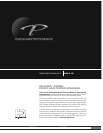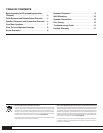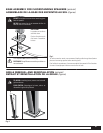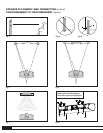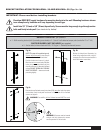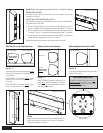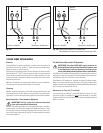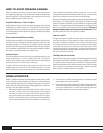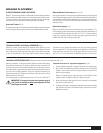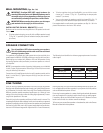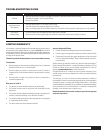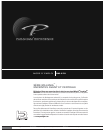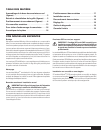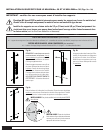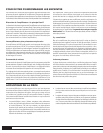
8
Millenia
™
speakers are efficient and can be driven to loud listening levels
with moderate amplifier power. They are also able to handle the output of very
powerful amplifiers. To prevent damage to your speakers, please read the
following guidelines before hooking them up.
Amplifier Distortion—The #1 Culprit!
Amplifier distortion is the principal cause of speaker damage. When listening
at loud levels your amplifier may run out of clean power. It will then begin to
produce distorted power several times greater than its rated output power.
This will damage any brand of speaker very quickly!
(See Dealer for amplifier
recommendations.)
More Powerful Amplifiers are Safer
A 40 watt/channel amplifier will have substantial distortion above 40 watts.
If driven to 50 watts, this amplifier will deliver distorted power which will
damage the speaker! A 100 watt/channel amplifier will have substantial
distortion above 100 watts, but very low distortion below 100 watts. Therefore,
when the speaker requires 50 watts, this more powerful amplifier will deliver
clean power and speaker damage is less likely to occur.
Volume Control
Do not be fooled by the Volume Control of your receiver/preamplifier. It only
adjusts listening level—it is not a “power-output” dial. The amount of
amplifier power actually used at a given Volume Control setting depends
solely on the nature of the music you are listening to.
At a given Volume Control setting a quiet section of music will use less
amplifier power than a loud section. With typical pop-rock, jazz or large
scale classical music, the rated output power of many receivers/amplifiers
is often reached when the Volume Control is between the “11 and 1 o’clock”
settings (with bass/treble and loudness controls not used—otherwise rated
power may be reached at even lower Volume Control settings).
Remember, all amplifiers produce distortion when operated beyond their rated
output power. The resulting distortion will damage all speakers! Exercise
caution! If you listen at loud levels, be careful to listen for the point of audible
distortion—if the speakers begin to sound distressed turn the Volume Control
down or your speakers and/or amplifier(s) will be damaged! This type of
damage constitutes abuse and is not covered by the warranty. If louder
volumes are desired, obtain a more powerful amplifier.
There is a Limit!
Although more powerful amplifiers are safer, there is a point at which you
could have more power than the speaker can handle. At that point you will
overpower the speaker and damage it. Exercise caution! At loud levels do
not increase bass/treble controls from zero and ensure that all loudness/
contour/bass EQ buttons are off (otherwise rated output power will be
reached at lower Volume Control settings). If you listen at loud levels, watch
for excessive visible cone excursion (grille movement) from the woofer—
then turn the Volume Control down.
The Right Amount of Power
A power-range rating is given as a guide to indicate the approximate minimum
and maximum power input of your Millenia
™
speakers. Amplifiers that exceed
your speaker’s power-range rating are recommended. Their greater power
reserves provide better sound. However, exercise caution! Use the speakers
within their power-range rating to prevent damage—keep listening levels
below the point of excessive woofer cone excursion.
HOW TO AVOID SPEAKER DAMAGE
Millenia
™
speakers are designed to provide superior high-end sound in a wide
variety of domestic settings. However, it is important to note that listening
room construction, dimensions and furnishings all play a part in the quality of
sound you will ultimately achieve. Keep the following guidelines in mind when
deciding on the best speaker placement:
• Mid and high frequencies are affected by the amount of soft furnishings
your room—curtains, carpets, sofas, wall coverings, etc. An excess of
such items can result in a somewhat dull sound. The same room with-
out any soft furnishings can produce a bright overall sound. The typical
quantity of soft furnishings found in most living situations provides the
right acoustic characteristics to allow the speakers to sound balanced.
• Concrete floors and walls tend to aggravate low-frequency standing
wave problems and are less preferred.
• Rooms where height, width and length are similar should be avoided as
they can exhibit significant low-frequency standing wave problems. This
may result in reduced clarity. If no other room is possible, experiment
with speaker placement to minimize acoustic problems.
ROOM ACOUSTICS



